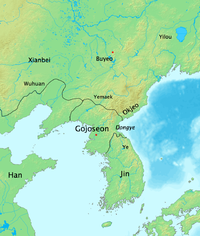
Back مملكة جن Arabic ژین (کوره دؤولتی) AZB Jin (Corea) Catalan Čin (stát) Czech Jin (Koreansk stat) Danish Jin-guk German Estado Jin (Corea) Spanish استان جین Persian Jin (Corée) French Csin (koreai állam) Hungarian
This article needs additional citations for verification. (June 2009) |
Jin state 진국 辰國 | |||||||||||
|---|---|---|---|---|---|---|---|---|---|---|---|
| 4th century BCE–2nd century BCE | |||||||||||
 Korea in 108 BCE | |||||||||||
| Capital | Not specified | ||||||||||
| Common languages | Unknown | ||||||||||
| Religion | Shamanism | ||||||||||
| Government | Tribal confederacy | ||||||||||
| Chief | |||||||||||
| Historical era | Ancient | ||||||||||
• Establishment | 4th century BCE | ||||||||||
• Succeeded by Samhan | 2nd century BCE | ||||||||||
| |||||||||||
| Today part of | South Korea North Korea | ||||||||||
| Jin | |
| Hangul | 진국 |
|---|---|
| Hanja | |
| Revised Romanization | Jinguk |
| McCune–Reischauer | Chin'guk |
| History of Korea |
|---|
 |
| Timeline |
|
|
The state of Jin (Korean pronunciation: [tɕin]) was a confederacy of statelets which occupied some portion of the southern Korean peninsula from the 4th to 2nd centuries BCE, bordering the Korean Kingdom of Gojoseon to the north. Its capital was somewhere south of the Han River. It preceded the Samhan confederacies, each of which claimed to be the successor of the Jin state.[1]
- ^ Lee Injae, Owen Miller, Park Jinhoon, Yi Hyun-Hae, 〈Korean History in Maps〉, 2014, pp.18-20